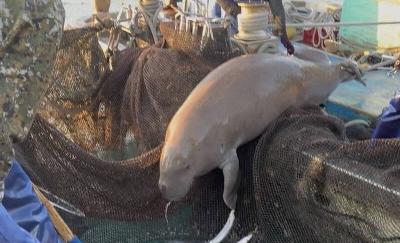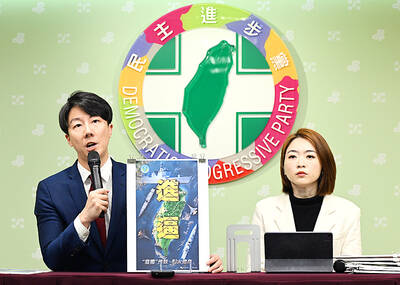While lauding the government for choosing the best technology available to detect melamine in food products, some health experts said more must be done to ensure accuracy and overall food safety.
The weeks-long controversy over which method to use to test for traces of melamine in foods didn’t end with the Department of Health’s decision on Wednesday to use liquid chromatography-tandem mass spectrometry (LC-MS/MS).
LC-MS/MS testing is capable of detecting melamine levels as low as 0.05 parts per million (ppm).
The department said the method would be used to test for melamine in the raw materials imported for use in creamers, milk powder and baby formula.
But the method to test for melamine in other, finished products remained unclear, with the department saying it would only conduct random checks of 20 percent of finished creamers, milk powders and baby formulas from “high-risk countries.”
Chan Chang-chuan (詹長權), a public health professor at the Institute of Occupational Medicine and Industrial Hygiene at National Taiwan University, praised health officials for choosing LC-MS/MS.
The technique is 500 times more sensitive in detecting melamine than high-performance liquid chromatography (HPLC), which was previously favored by the health department.
A provisional statement by the European Food Safety Authority (EFSA) on June 7 said that the European Commission had recommended that all EU member states use gas chromatography-mass spectrometry (GC-MS) to analyze imports of wheat gluten and other raw materials from developing countries — in particular China.
The statement came after the US Food and Drug Administration (FDA) used the method to test for melamine and similar compounds in wheat gluten and pet food ingredients from China.
Toxic ingredients from China killed or sickened thousands of dogs and cats in the US last year, prompting a public outcry.
The WHO has said that as of Sept. 25, more than 54,000 infants and children in China had been taken to hospitals and clinics for treatment of urinary problems — such as renal tube blockages and kidney stones — related to the presence of melamine in infant formula and other dairy products.
The WHO also said that more than 14,000 infants had been hospitalized after ingesting the contaminated formula, of which a little less than 13,000 remained in hospitals.
“LC-MS/MS is a more precise instrument than GC-MS, so it is good [that the health department adopted the former]. But what is more important is that we should make our own risk assessment of melamine, given Taiwan’s close relationship with and proximity to China,” Chan said.
Whether the tolerable limit of melamine set by the government is in line with international safety standards has been a source of debate since the melamine scare erupted last month.
The health department came under fire when it decided on Sept. 24 to use HPLC to test for melamine and to change the safety limit for the chemical from zero ppm to 2.5ppm, meaning products containing up to 2.5ppm of melamine would not be blocked.
Department of Health minister Lin Fang-yue (林芳郁) resigned the following day in response to fierce public criticism.
But when Yeh Ching-chuan (葉金川) took over Lin’s post on Sept. 26 and announced that LC-MS/MS would be used instead of HPLC, Nestle, one of the leading makers of infant and adult milk products, was quick to object.
Last Thursday, the health department requested a recall of all 20 Nestle milk products on the market after it said random tests conducted by city and county health bureaus found that six kinds of Nestle milk powder manufactured in China contained between 0.06ppm and 0.85ppm of melamine.
While the company said it would comply with the request, it complained that the department had adopted a melamine limit that was 50 times stricter than the international standard, which Nestle said was 2.5ppm.
“Both the US and the EU have established tolerable daily intake [TDI] levels for melamine, but how many parts per million of melamine is permissible in food is not very clear in their food safety standards,” said Ling Yong-chien (凌永健), a chemistry professor at National Tsinghua University.
TDI represents an estimate of how much of a chemical can be ingested daily in food or water over a lifetime without posing a significant risk to health.
In the US, the FDA published a provisional risk assessment on melamine and related compounds on May 27 last year, putting TDI for melamine at 0.63mg per kilogram of body weight per day.
EFSA’s statement last June, meanwhile, recommended that EU countries adopt a TDI of 0.5mg per kilogram of body weight per day.
The FDA risk assessment analyzed “the risk to human health associated with eating pork, chicken, fish and eggs from animals that had been inadvertently fed animal feed adulterated with melamine and its analogues” following the pet food incident.
Based on these TDI figures, some experts in Taiwan have said that 2.5ppm is an acceptable limit for dairy and other food products because an adult weighing 60kg can safely consume 30mg of melamine per day, or more than 12kg food contaminated with 2.5ppm of melamine.
The average adult weighing 60kg eats 3kg of food per day.
But Ling said it was inappropriate to set a limit for melamine based on TDI, which is used in risk-assessment of human exposure to dioxin-like pollutants. The safety of food additives are based on allowable daily intake (ADI) calculations, Ling said.
Lee Maw-rong (李茂榮), director of the Department of Chemistry at National Chung Hsing University, agreed, saying that TDI describes the toxicity of a compound and not the amount a person can eat.
“It’s just like you can’t ask if 1m is more than 1kg. Or morphine, for example: Its TDI is set at 0.1mg per kilogram of body weight per day, or 0.001ppm, but who eats morphine every day?” Lee asked.
Yang Chen-chang (楊振昌), a toxicologist at Taipei Veterans General Hospital, had a different opinion.
“The conversion between TDI and parts per million is not wrong. But the problem with melamine now is not just a matter of science. Too many factors are involved in the issue — public opinion on the government’s handling of the problem and people’s different views about the same risk assessment,” Yang said.
While some have said that the limit of 2.5ppm of melamine is the permissible level of melamine in food in the US, the EU and New Zealand, that too has been called into question.
The documents that have been cited to prove that 2.5ppm is the limit in these countries were interpreted incorrectly, some say.
Taking the EU as an example, many people, including Yang, say that the union adopted the 2.5ppm level when it asked that member states immediately destroy any Chinese products with at least 15 percent milk that are found to contain melamine in excess of 2.5mg per kilogram.
That recommendation was made on Sept. 26 in a European Commission document on how to handle imports of dairy products and ingredients from China.
But Lee and Ling both said the EU stopped short of saying that the permissible level of melamine in food should be permanently set at 2.5ppm.
“The EU also stated in the document that it would reassess the appropriateness of the measures, which makes the measures seem to be temporary provisions implemented for this emergency situation only,” Lee said.
In the case of the US, the FDA said on Friday on its Web site that “in food products other than infant formula, the FDA concludes that levels of melamine and melamine-related compounds below 2.5 parts per million do not raise concerns.”
But Hsieh Yen-yao (謝炎堯), vice superintendent of the Koo Foundation Sun Yet-Sen Cancer Center, said the US FDA had set a level of 0.05ppm for pork, chicken, fish and eggs.
That restriction is stated in the FDA’s risk assessment from last May.
Most countries have not set a tolerable level of melamine for food products before as the toxic chemical has not been considered a food additive, Lee said. The melamine limits set by countries previously have referred to accidental contamination.
“Rather than debating what the permissible level is, what we should do is to make sure that we can accurately detect any presence [of melamine] using the most sensitive detection instruments and ensure that the detection is conducted in accordance with standard operating procedures in laboratories,” Ling said.

‘DENIAL DEFENSE’: The US would increase its military presence with uncrewed ships, and submarines, while boosting defense in the Indo-Pacific, a Pete Hegseth memo said The US is reorienting its military strategy to focus primarily on deterring a potential Chinese invasion of Taiwan, a memo signed by US Secretary of Defense Pete Hegseth showed. The memo also called on Taiwan to increase its defense spending. The document, known as the “Interim National Defense Strategic Guidance,” was distributed this month and detailed the national defense plans of US President Donald Trump’s administration, an article in the Washington Post said on Saturday. It outlines how the US can prepare for a potential war with China and defend itself from threats in the “near abroad,” including Greenland and the Panama

A wild live dugong was found in Taiwan for the first time in 88 years, after it was accidentally caught by a fisher’s net on Tuesday in Yilan County’s Fenniaolin (粉鳥林). This is the first sighting of the species in Taiwan since 1937, having already been considered “extinct” in the country and considered as “vulnerable” by the International Union for Conservation of Nature. A fisher surnamed Chen (陳) went to Fenniaolin to collect the fish in his netting, but instead caught a 3m long, 500kg dugong. The fisher released the animal back into the wild, not realizing it was an endangered species at

The High Prosecutors’ Office yesterday withdrew an appeal against the acquittal of a former bank manager 22 years after his death, marking Taiwan’s first instance of prosecutors rendering posthumous justice to a wrongfully convicted defendant. Chu Ching-en (諸慶恩) — formerly a manager at the Taipei branch of BNP Paribas — was in 1999 accused by Weng Mao-chung (翁茂鍾), then-president of Chia Her Industrial Co, of forging a request for a fixed deposit of US$10 million by I-Hwa Industrial Co, a subsidiary of Chia Her, which was used as collateral. Chu was ruled not guilty in the first trial, but was found guilty

The Chinese Nationalist Party (KMT) is maintaining close ties with Beijing, the Democratic Progressive Party (DPP) said yesterday, hours after a new round of Chinese military drills in the Taiwan Strait began. Political parties in a democracy have a responsibility to be loyal to the nation and defend its sovereignty, DPP spokesman Justin Wu (吳崢) told a news conference in Taipei. His comments came hours after Beijing announced via Chinese state media that the Chinese People’s Liberation Army’s Eastern Theater Command was holding large-scale drills simulating a multi-pronged attack on Taiwan. Contrary to the KMT’s claims that it is staunchly anti-communist, KMT Deputy